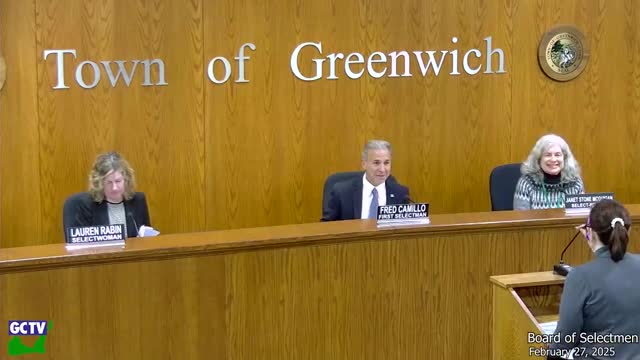Selectmen begin review of 2025 outdoor dining guidelines; barrier costs, season dates debated
March 08, 2025 | Town of Greenwich, Fairfield, Connecticut
This article was created by AI summarizing key points discussed. AI makes mistakes, so for full details and context, please refer to the video of the full meeting. Please report any errors so we can fix them. Report an error »

Town staff presented a first reading of proposed 2025 outdoor dining guidelines at the Board of Selectmen meeting on Feb. 27, outlining a shorter season and an incremental increase to barrier fees used to secure outdoor dining areas.
"We have made a couple of recommended changes in the guidelines. One is to shorten the season a bit, beginning right before Memorial Day and ending mid-October. The other is to increase the cost ... for the barriers to recognize the cost that the town incurs to put them in place," said Kate Bush, town administrator and chief operating officer, during the presentation.
Bush said the proposal would not immediately raise barrier fees to the full town cost, but would move to that level in phases. Selectmembers questioned the exact pricing and asked staff to provide a clear per-stall or per-foot cost breakdown at the next meeting. Selectwoman Janet Stone McWiggin asked whether the (proposed) increase would be a large jump; staff said the current referenced figure rose from about $29 to $47 (the meeting record shows that change would add roughly $12 per linear unit in the barrier component) and that the total financial impact per restaurant would likely be in the low hundreds of dollars depending on how many parking stalls are converted.
Board members and staff reiterated that occupancy limits remain a Department of Health determination. "The occupancy is determined by the Board of Health — that permit, not this forum," said Selectwoman Lauren Rabin.
Discussion also addressed aesthetics and logistics: members recalled a 2024 design contest for barrier wraps and described a preference for solutions that are durable and not visually distracting, with a suggestion to explore wooden planter-box-style barriers that could be privately funded and easier for DPW to maintain. John Conte, a town landscape architect mentioned by staff, said he would help with design options.
No vote was taken on the guidelines at the Feb. 27 meeting; staff and the board agreed to return the item for a second read at the board's March meeting on March 13. Staff was asked to provide exact fee calculations and examples of barrier designs for that session.
The discussion was procedural and policy-oriented; no regulatory change or fee increase takes effect until the board acts on a subsequent reading and adopts a final guideline.
"We have made a couple of recommended changes in the guidelines. One is to shorten the season a bit, beginning right before Memorial Day and ending mid-October. The other is to increase the cost ... for the barriers to recognize the cost that the town incurs to put them in place," said Kate Bush, town administrator and chief operating officer, during the presentation.
Bush said the proposal would not immediately raise barrier fees to the full town cost, but would move to that level in phases. Selectmembers questioned the exact pricing and asked staff to provide a clear per-stall or per-foot cost breakdown at the next meeting. Selectwoman Janet Stone McWiggin asked whether the (proposed) increase would be a large jump; staff said the current referenced figure rose from about $29 to $47 (the meeting record shows that change would add roughly $12 per linear unit in the barrier component) and that the total financial impact per restaurant would likely be in the low hundreds of dollars depending on how many parking stalls are converted.
Board members and staff reiterated that occupancy limits remain a Department of Health determination. "The occupancy is determined by the Board of Health — that permit, not this forum," said Selectwoman Lauren Rabin.
Discussion also addressed aesthetics and logistics: members recalled a 2024 design contest for barrier wraps and described a preference for solutions that are durable and not visually distracting, with a suggestion to explore wooden planter-box-style barriers that could be privately funded and easier for DPW to maintain. John Conte, a town landscape architect mentioned by staff, said he would help with design options.
No vote was taken on the guidelines at the Feb. 27 meeting; staff and the board agreed to return the item for a second read at the board's March meeting on March 13. Staff was asked to provide exact fee calculations and examples of barrier designs for that session.
The discussion was procedural and policy-oriented; no regulatory change or fee increase takes effect until the board acts on a subsequent reading and adopts a final guideline.
View full meeting
This article is based on a recent meeting—watch the full video and explore the complete transcript for deeper insights into the discussion.
View full meeting
